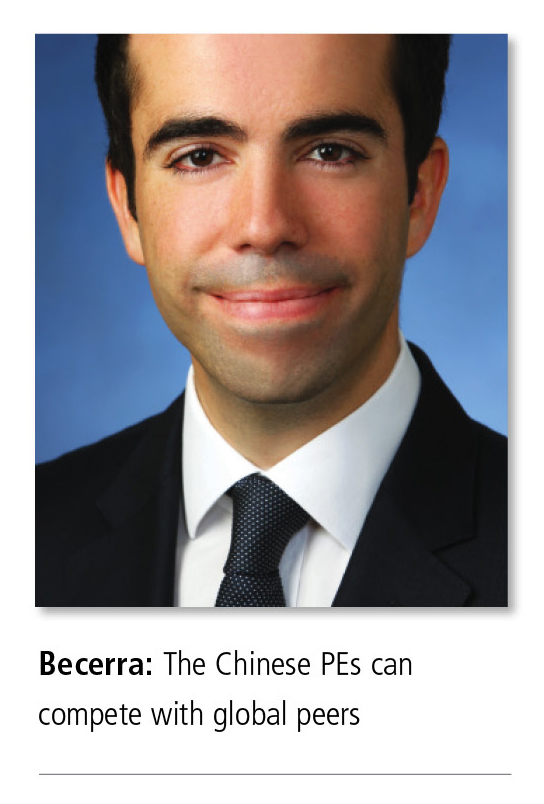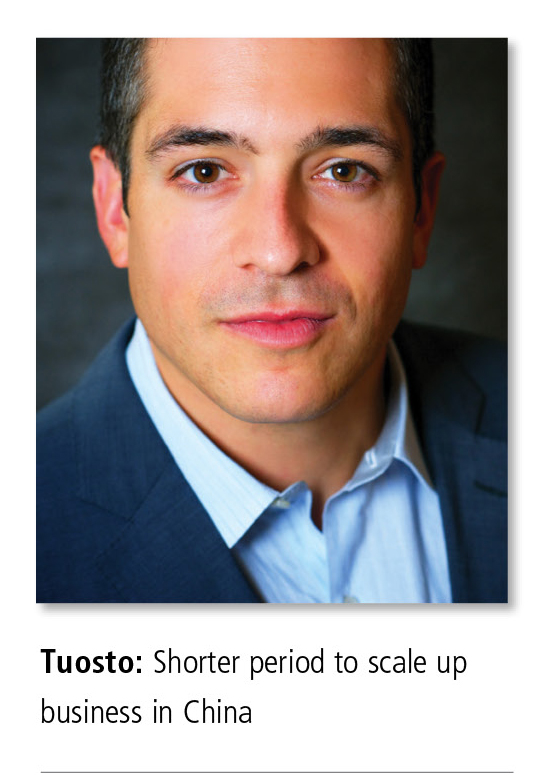As China outbound M&A activity hit record high in 2016, it is not surprising that the Chinese private equity (PE) firms are getting into the act as well. For one thing, the Chinese PE market is growing at a fast pace as asset managers, insurance companies and pension funds are looking to further diversify their capital in other assets that are not equity or bonds. At the same time, the PE firms have become a lucrative ground for many former high-calibre investment bankers to channel their deal making prowess.
As this develops, the Chinese PE firms’ DNA has changed quite a bit during the past half-decade as Enrique Becerra, Managing Director for Asia-Pacific Financial Sponsors at Bank of America Merrill Lynch, points out. Previously, their bread and butter were pre-IPO investments into growth companies in China of anywhere from US$50 million to US$200 million, and would later look to exit these investments through an IPO.
 |
While they still continue to arrange these types of investment for the right transactions, their strategy is changing. “The Chinese PEs now have sufficient capital to allow them to compete with global PE firms,” notes Becerra. “Back in 2010, the size of the Chinese PE funds typically ranged between US$1 billion and US$2 billion. These days, they are managing funds amounting to US$3 billion to US$4 billion. They have a lot more money at their disposal and that allow them to look at larger transactions, and these transactions tend to be not in China, but overseas.”
In the first half of 2016, China-based PE funds have invested US$7.4 billion through cross-border deals into Europe and North America – already exceeding the US$5.8 billion invested in 2015, according to a November 2016 report by the international investment bank Houlihan Lokey. It notes that from 2011 to the first half of 2016, China-based PE firms have engaged in 13 PE investments worth US$1.6 billion, 23 PE buyouts valued at US$15.7 billion and 78 venture capital investments worth US$1.9 billion.
In terms of targets, the Chinese PE firms have been looking at various sectors. For instance, they are looking at higher value-added products such as automotive components, which have particular technology that they can bring back to China and sell in domestic market.
But there are issues with these types of asset. “From the PE perspective, adopting this technology in China takes longer than a PE investment holding period,” argues Becerra. “You cannot bring a technology to China and expect the market to adopt it, grow the business in two years and then sell it. It does not happen that fast.”
The Chinese PE firms are also scouting for brands, either in apparel, food & beverage and lifestyle – hoping to grow these brands in China by opening stores or restaurants.
These are good assets, but the problem is while the brands have a lot of potential in China, Becerra says developing that potential is not easy as it requires capital to be able to scale up the business by opening stores and other outlets.
Scaling business quickly
The latest targets, though, among the Chinese PE firms are rather interesting, says Becerra. They are looking at content-type deals – anything from sport franchises to interactive entertainment, such as online and mobile games as well as films, television and even data analytics.
“Those types of assets can scale in China when they find partner with industry expertise,” says Nicholas Tuosto, Director and Head of Interactive Entertainment, Investment Banking, at Bank of America Merrill Lynch. “For instance, private equity firms participated in the Tencent acquisition of Supercell, the maker of the hit Clash of Clans and Clash Royale mobile games. With the acquisition, Tencent is able to expose millions of users in China to Supercell’s games, with its expertise in China games industry. They do not need to wait for years to see a meaningful business in China result given the established ecosystem and experiences.”
The Chinese PE firms are also looking for anything that is related to consumer upgrade, bringing better lifestyle to people, such as healthcare and personal experience services like tourism. “The Chinese consumers cannot continue to improve their lifestyle by buying another expensive or branded bag, which many people can buy online anyway. Instead, they want to enjoy a nice vacation and that is special to them.”
What makes the Chinese PE firms competitive is their flexibility in deal-making approach compared with the traditional PE funds because they come from a different background. “The DNA of the traditional PE firms, which continue to be successful, is to secure deals through LBO-type of transactions,” says Becerra. “That is how they’ll be looking at the assets when they become available in the US and Europe.”
The Chinese PE funds, on the other hand, are flexible in terms of deal structure – it could be equity, convertible bonds or some sort of structured securities. They are also flexible in terms of control and they can be creative when they want to get the deal done. In occasions, they act similar to a merchant bank, partnering with a Chinese strategic buyer with which they have a long standing relationship, advising them, and taking equity in the target or combined business.
Another advantage they have over their global peers is their ability to act quickly for mid-size assets with cross-border exposure. The global PE firms typically manage a few funds in Asia, the US and Europe, and when an asset comes into play, they still need to decide which among the funds is going to lead the transaction.
 |
The Chinese PE firms, meanwhile, typically manage just one fund, with the founder still in charge and very much involved in the day-to-day running of the business. “If they see something they like, they can act on it quickly,” Becerra says.
But the Chinese PE firms have their drawbacks as well. For one thing, they still lack a long standing track record of operating businesses in the US and Europe, and as a result, they need to rely on the existing management of the target company to continue to run the business. In contrast, the global PEs have been in those markets for a long time, so when problems come up, they can find the solution quicker than those PEs that only have a few years of exposure in the particular market.
Nonetheless, the Chinese PE firms are demonstrating their capability to acquire assets viz-a-viz their global peers. Says Becerra: “The proof is out there – they are getting deals done. The real test comes at the time of realizing the exit, which there are few promising examples already.”
Chinese bank financing
One of them is FountainVest Partners, which sold its stakes in early 2016 in Key Safety Systems (KSS), a US-headquartered global leader in the design, development and manufacturing of automotive safety-critical components and systems, to Ningbo Joyson Electronic Corporation in a cash transaction valued at about US$920 million.
FountainVest, together with Canada Pension Plan Investment Board as a co-investor, bought a majority stake in KSS in 2014 for a reported US$700 million to US$800 million.
“There are deals that come in three to five-year cycle which are coming into the exit stage now,” says Becerra. “We need a longer track record to see if the Chinese PE firms have really been able to add value to the business and find an interesting exit.”
Apart from the available pool of capital, what also makes the Chinese PE firms capable of competing with their global peers is the financing made available by the Chinese domestic banks. One of the challenges that the Chinese PE firms used to face was financing since it was very much relationship driven for banks when it comes to financing LBO type of deals.
“It needs to be the right buyer, the right target to finance and the right credit structure,” says Becerra. “The deal should also involve an owner who has a proven track record of managing leveraged assets that can steer the business when it gets into trouble. He must be someone who the banks know and debt investors are comfortable with.”
But things are changing because the Chinese domestic banks are becoming very much involved in these deals. “They are looking at how the global banks and the global debt investors are investing in these deals,” notes Becerra. “These domestic banks are learning from them and are providing capital on that basis. They are familiar with the Chinese PE firms and are helping them to get the deals done, so the leverage now is like on par.”
The Chinese banks are now able to deliver leveraged packages that are on par with what a foreign PE would get from a global bank. “If you think about it, these banks are previously not familiar with the LBO transactions,” Becerra points out. “Now, they see how the European investors, for instance, get comfortable with deals that have 5x or 6x leverage.”
What the Chinese banks are also doing for their clients is to structure transactions that offer a little more than what the borrower can get in the US, such as extending tenor a little bit longer, adding a little bit more leverage and creating a covenant package that monitors the business and allows them sufficient room to operate.
So going forward, Chinese PE firms will continue to figure in China’s outbound M&A transactions. And with PE as a growth industry, there will be new players coming into the market. PE as an asset class is still under-invested in China and, therefore, will continue to grow as capital is available to arrange transactions.








